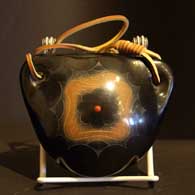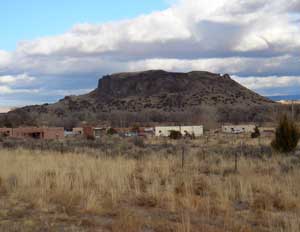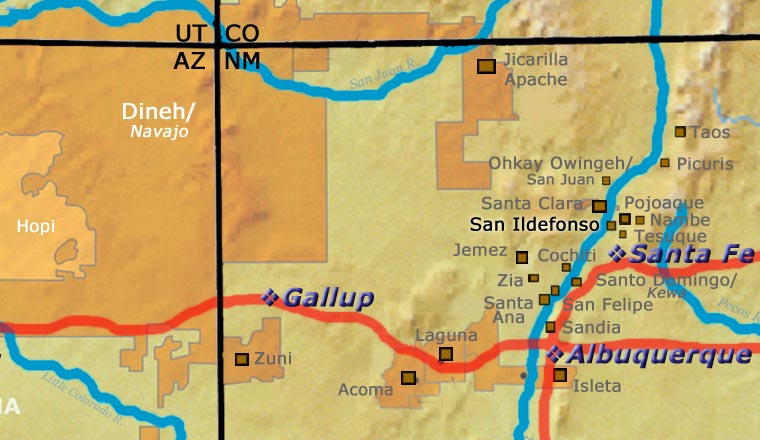
Barbara Gonzales
San Ildefonso
Born in 1947, Barbara Gonzales is the great-granddaughter of Maria Martinez and granddaughter of Adam and Santana Martinez. She credits her great-grandmother with changing the making of pottery from a craft to a fine art, and then credits her with being a major force in the shaping and evolution of that fine art.
Barbara lived in Maria's home from the time she was five until she was ten. That is when she learned the basics of the traditional way of making pottery from her great-grandmother. Barbara says pottery making was such an integral part of Maria's family life that she organically assimilated the skills simply from being in the presence. She also traveled with Maria to sell pots to tourists under the portal at the Palace of the Governors in Santa Fe and at the train depot in Albuquerque. Her own first pieces were simple animal sculptures, then she progressed into small pots, then bowls and spheres. Slowly Barbara developed her style of small sculptures, polychrome pottery and stone-inlaid, sgraffito-etched red and black ware. Along with Popovi Da she was one of the early adopters of the two-tone technique (involving two firings to produce sienna effects on otherwise black pots). She also used inlaid turquoise, heishi beads and gemstones. Around 1973 she originated "the Spider" and "the webbing technique" in sgraffito on black pottery. That shortly became her trademark.
Barbara participated in the Santa Fe Indian Market for many years, earning First, Second and Third Place ribbons often. She was included in the Maria Martinez: Five Generations of Potters exhibition at the Renwick Gallery in 1978 and the Masters of Indian Market exhibition at the Santa Fe Indian Market in 1996.
Barbara was chosen as a representative of Maria's "craft lineage" in the 1997-8 Pottery by American Indian Women, The Legacy of Generations exhibition of the National Museum of Women in the Arts.
Some of the Awards Barbara has Won
- 2000 Santa Fe Indian Market, Classification II - Pottery, Division H - Non-traditional pottery, any forms using non-traditional materials or techniques, Category 1520 - Miscellaneous, unpainted: Second Place
- 1996 Santa Fe Indian Market, Classification II - Pottery, Division H - Non-traditional any forms using non-traditional materials or techniques, Category 1510 - Single figures, (animal & other), all other: First Place
- 1995 Santa Fe Indian Market, Classification II - Pottery - Division E - Traditional pottery, painted designs on burnished black or red surface: Best of Division
- 1995 Santa Fe Indian Market, Classification II - Pottery - Division E - Traditional pottery, painted designs on burnished black or red surface, Category 1203 - Bowls, over 6 inches in diameter: First Place
- 1995 Santa Fe Indian Market, Classification II - Pottery - Division E - Traditional pottery, painted designs on burnished black or red surface, Category 1206 - Plates: Third Place
- 1995 Santa Fe Indian Market, Classification II - Pottery - Division E - Traditional pottery, painted designs on burnished black or red surface, Category 1207 - Miscellaneous: First Place
- 1990 Santa Fe Indian Market, Classification II - Pottery, Division J - Non-traditional, any forms using non-traditional materials or techniques, Category 1403 - Jars & vases, unpainted (other than stoneware): Second Place
- 1988 Gallup InterTribal Ceremonial, Classification IV - Pottery-jar, seed jar, canteen: Third Place
- 1983 Santa Fe Indian Market, Classification II - Pottery, Division E - Traditional, painted designs on burnished black or red surface: Second Place
- 1977 Heard Museum Guild Indian Arts & Crafts Exhibit, Classification VII - Pottery, Division C - Miniatures, under 2-1/2": Second Place
- 1974 12th Annual Scottsdale National Indian Arts Exhibition, Section C - Crafts, Classification VIII - Pottery, Division B - Adaptations: Honorable Mention
100 West San Francisco Street, Santa Fe, New Mexico 87501
(505) 986-1234 - www.andreafisherpottery.com - All Rights Reserved

San Ildefonso Pueblo
San Ildefonso Pueblo is located about twenty miles northwest of Santa Fe, New Mexico, west of Pojoaque, south of Santa Clara and straddling the Rio Grande. Although their ancestry has been traced to prehistoric pueblos in the Greater Mesa Verde area, the prehistoric pueblo at Tsankawi, in a non-contiguous parcel of Bandelier National Monument, is their most recent ancestral home. Tsankawi abuts the reservation on its northwest side.
Franciscan monks named the village after San Ildefonso and in 1617, forced the tribe to build a mission church on top of the village's main kiva. Before that the village was known as Powhoge, "where the water cuts through" (in Tewa). Today's pueblo was established as long ago as the 1300s. When the Spanish arrived in 1540, they estimated the village population at about 2,000.
That mission was destroyed during the Pueblo Revolt of 1680 and when Don Diego de Vargas returned to reclaim San Ildefonso in 1694, he found virtually all the Tewa people camped out on top of nearby Black Mesa. After an extended siege the two sides negotiated a treaty and the people returned to their villages. However, the next 250 years were not so good for them.
The swine flu pandemic of 1918 reduced the pueblo's population to about 90. Their population has grown to more than 600 since but the only economic activity available on the pueblo itself involves creating art in one form or another. The only other work is off-pueblo. San Ildefonso's population is small compared to neighboring Santa Clara Pueblo, but the pueblo maintains its own religious traditions and ceremonial feast days.
San Ildefonso is most known for being the home of the most famous Pueblo Indian potter, Maria Martinez. Many other excellent potters from this pueblo have produced quality pottery, too, among them: Blue Corn, Tonita and Juan Roybal, Dora Tse Pe and Rose Gonzales. Of course, the descendants of Maria Martinez are still important pillars of San Ildefonso's pottery tradition. Maria's influence reached far and wide, so far and wide that even Juan Quezada of the Mata Ortiz pottery renaissance in Chihuahua, Mexico, came to San Ildefonso to learn from her.
100 West San Francisco Street, Santa Fe, New Mexico 87501
(505) 986-1234 - www.andreafisherpottery.com - All Rights Reserved

